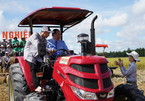In the thirty years of Doi Moi, Vietnam’s agricultural sector brought the country out of a prolonged period of poverty and became a net exporter in 1989. Local agriculture has maintained average growth of some 3.5% each year in the time since.
Vietnam’s agricultural sector posted export value of a mere 486.2 million USD in 1986, when the Doi Moi process kicked off. Fourteen years later, the figure had soared to 4.2 billion USD and by 2018 stood at a record 40.2 billion USD. With ten commodities earning annual export value of more than a billion dollars, Vietnam now counts among the world’s largest exporters of agro, forestry, and fisheries products.
In 2018, the agricultural sector’s GDP reached 3.76%, against Vietnam’s nearly 7%, revealing the important contribution the sector makes to the national economy.
Still, given the complex developments of climate change and the challenges posed by increasingly deep international cooperation, the local agricultural sector must continually reform to adapt and thrive.
The Government has set several targets for the agricultural sector over a ten-year timeframe, including Vietnam joining the list of the 15 leading countries with the most developed agricultural sector and the top 10 in farm produce processing, and becoming a global production hub for wood and wooden products as well as a major shrimp production house for the world. Annual agricultural growth is set to be at least 3%, with annual export value of between 42 and 43 billion USD./.VNA

Has Vietnam’s sustainable agriculture developed well?
Consuming green organic farm produce is a growing tendency in Vietnam. Meanwhile, the scale of the sustainable agriculture remains modest.